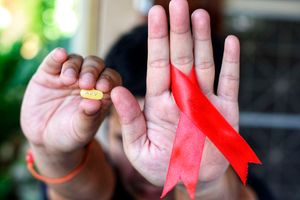Trapped by floods: How disasters are fueling Kenya’s hidden HIV crisis

Extreme weather events are disrupting healthcare access, forcing missed ARV doses and PrEP refills.
What you need to know:
- New studies reveal that extreme weather events, from floods to prolonged droughts, are driving a silent crisis in sexual and reproductive health, especially among adolescents, sex workers, and sexually diverse men.
When flash floods submerged Nairobi's Kawangware slum last May, they didn't just destroy homes— they cut off Mwende* from her lifesaving HIV medication. For days, the 22-year-old couldn't reach the local clinic for her antiretrovirals (ARVs) refill, leaving her exposed.
Mwende watched the calendar tick closer to the moment her ARVs run out—her health held hostage by climate change. She feared that the virus would multiply, weaken her immune system, and make her potentially become resistant to medications for missing doses of her ARVs.
“The water was everywhere and when the pills ran out, I just had to wait. It made me feel powerless, like the floods were controlling my health.”
As climate change tightens its grip across Kenya, its most devastating effects are unfolding far beyond the headlines of failed crops and dry riverbeds. New studies reveal that extreme weather events, from floods to prolonged droughts, are driving a silent crisis in sexual and reproductive health, especially among adolescents, sex workers, and sexually diverse men.
Two studies published in BMJ Global Health and AIDS and Behavior this month underscore an alarming trend, documenting how rising food, water, and sanitation insecurities are putting vulnerable groups at higher risk of school dropout, gender-based violence, early pregnancy, and HIV infection. Extreme weather events are also disrupting healthcare access, forcing missed ARV doses and PrEP refills.
For young women like Mwende, such service disruptions do not just pose logistical challenges; they threaten hard-won progress in the fight against HIV.
One of the studies published in BMJ Global Health highlights that climate-related stressors and extreme weather events can worsen sexual and gender-based violence and HIV risks through factors like poverty, displacement, damaged infrastructure, and gender inequities.
Drought has been linked to reduced HIV testing and higher HIV prevalence, especially among rural adolescent girls and women. These conditions may drive transactional sex, expand sexual networks, and increase exposure to HIV and sexually transmitted infections.
The study identified multiple direct and indirect pathways linking extreme weather events to poor Sexual and Reproductive Health (SRH) outcomes. Droughts and floods disrupted food systems, contributing to school dropout, street involvement and homelessness, and sexual exploitation. Water shortages were linked to educational disruptions as well as exposing girls to harassment and violence at collection sites. Lack of access to safe sanitation contributed to menstruation-related school absences and coercive sexual encounters in exchange for menstrual supplies.
Public health issue
“Climate change isn’t just an environmental issue, it’s a public health emergency for marginalised populations,” said Dr Carmen Logie, lead author of the studies, professor at the University of Toronto, and an adjunct professor at the United Nations University Institute for Water, Environment, and Health.
“In Kenya, we heard stories from young adolescents and key populations alike who are navigating impossible trade-offs just to survive.”
The study published in BMJ Global Health and AIDS and Behavior notes that Kenyan girls aged 15–19 account for more than 80 per cent of new HIV infections among adolescents.
Youth aged 15–24 accounted for 41 per cent of Kenya’s new HIV infections in 2022, with adolescent girls and young women comprising 78 per cent of these infections. Yet there is limited knowledge of the lived experiences of climate change and SRH among young adolescents aged 10–14 in high HIV prevalence contexts, according to the researchers.
In one study, researchers spoke with 178 adolescents and 119 community elders in Nairobi’s Mathare slum, Naivasha’s flower farming community, Kisumu’s fishing community, Isiolo’s nomadic and pastoralist community, Kilifi’s coastal smallholder farms and Kalobeyei refugee settlement. They found that climate change-induced disruptions in food and water systems are placing adolescents, especially girls aged 10–14 years, at increased risk of dropping out of school, entering exploitative relationships, and experiencing early pregnancy.
“Girls told us about the shame of skipping school or engaging in transactional sex to access basic necessities,” said Aryssa Hasham, a co-author of the study.
“These are not isolated stories. They reflect gendered systems of vulnerability made worse by climate stress.”
In a parallel study, researchers engaged 21 sex workers and 15 men who have sex with men in Nairobi to understand how extreme weather and stigma intersect to heighten HIV risk. Participants shared how drought and flooding led to food and water shortages, forcing some into riskier transactional sex with reduced ability to negotiate condom use.
Also read: Treasury cuts HIV, tuberculosis and malaria allocation even after Sh31bn USAID withdrawal gap
“Intersecting stigmas related to sex work and LGBTQ identity intensify the harm of extreme weather events,” said Humphres Evelia, executive director of the Centre for the Study of Adolescence. “Participants described increased exposure to violence, reduced access to healthcare, and greater economic precarity, all worsened by climate-induced resource scarcity.”
One man recounted missing refills of PrEP, a daily HIV prevention pill, because flash floods made roads impassable.
“Such disruptions can have long-term consequences for HIV prevention and care. We need climate-informed, adolescent-centered, and gender-transformative programming that addresses the root causes of insecurity,” said Dr Julia Kagunda, co-author and director of Elim Trust in Kenya. She cited mobile health services, youth-led safe spaces, and expanded access to long-acting HIV prevention options like injectable PrEP.
The researchers also call for stronger integration of SRH and HIV services within Kenya’s climate adaptation strategies; with special consideration for marginalised groups often excluded from policy discussions.
“While the impacts of climate change are widespread, their burden is not equally shared,” said Logie. “We must prioritise solutions that protect those most at risk, not just from environmental collapse, but from the social systems that make survival harder for some than others.”


